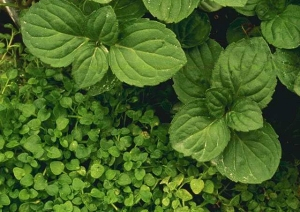Peppermint Characteristics
(Mentha piperita, Linn.)

Name Origin:
Peppermint is a hybrid mint, a cross between watermint and spearmint.
Natural Order:
Lamiaceæ
Peppermint Growing Cycle:
Perennial Herb
Origins:
Northern Europe and England. More on the History of Peppermint.
Height:
Grows 1-3 feet tall
Characteristics:
Like other mints, peppermint (mentha piperita) can quickly overtake a garden. Peppermint plants have ovate, smooth leaves on stalks often longer that that of mint (mentha viridis).
Peppermint Flowers:
Little, reddish-violet flowers on spikes.
Peppermint Facts:
Sanitary engineers once used peppermint oil to test the tightness of pipe joints. The strong scent of peppermint oil has the “faculty of making its escape and betraying the presence of leaks.”
Growing Peppermint
(cultivation and harvest.)

Growing Peppermint & Peppermint Cultivation.
Growing peppermint plants can quickly become out of control without proper care with their creeping rootstocks. A large patch might be mowed, with the blade being at the highest setting in early spring, to generate fresh and compact growth. When thinning peppermint plants, be sure to get all of the root otherwise those roots will sprout into new plants.
Want to know more about growing peppermint? Check out our peppermint companion planting guide.
Harvesting Peppermint Leaves
Snip peppermint leaves anytime. To harvest large amounts, cut plants at their base before blooming starts. The first year’s crop is thought to be the most aromatic and valuable. Successive years will yield fewer leaves that are progressively less aromatic. Some commercial peppermint farmers used to “plow up” their entire field every three years to renew the crop. After this treatment, the yield will resemble that of the second year’s harvest.
Peppermint Uses
Peppermint Oil
Of all the essential oils derived from herbs, peppermint ranks first in importance. The oil is fairly colorless with a slight yellow or greenish cast which has a strong odor and a burning camphorescent taste.
Peppermint oil is frequently used in the manufacture of soaps and perfumery but it most prized for use in flavoring confectionery, chewing gum, medicines, toothpaste and the liqueur, creme-de-menthe.
Additional Peppermint Information
There are a number of similar plants in the mint family. This article refers to mentha piperita. We also have an article on menta viridis.
Before growing peppermint, you might want to look over our peppermint companion planting guide to learn what other herbs and plants do well when planted with peppermint and those plants that you should not plant with peppermint.
Peppermint plants are thought to be native to England. The history of peppermint is covered in more detail in another article.
Looking for tasty ways to use your peppermint plants? Check out our mint punch recipe.